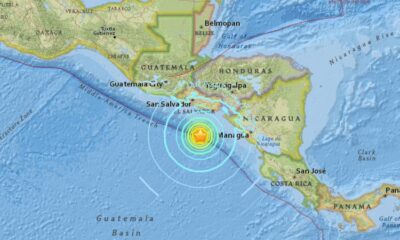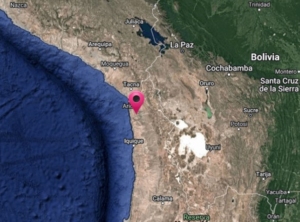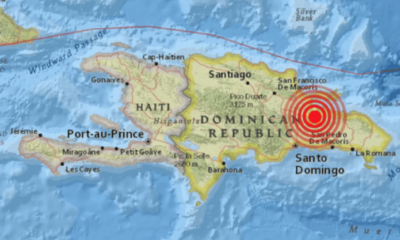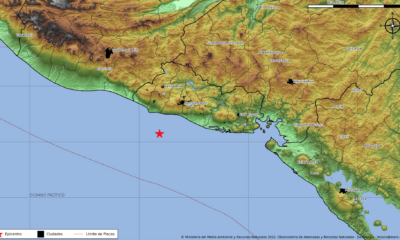International
Earthquake shakes the Panama-Colombia border
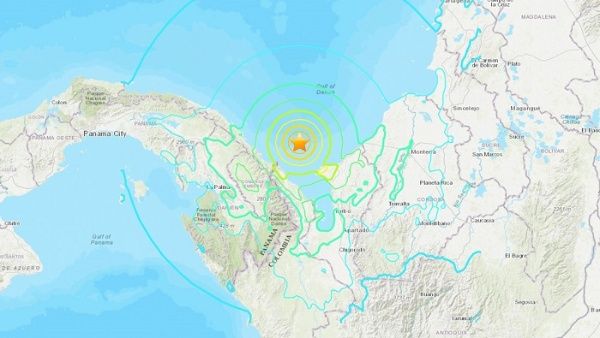
May 25 |
Several earthquakes shook the border area between Colombia and Panama on Wednesday night, with the strongest of them registering a 6.6 magnitude quake.
The Colombian Geological Service reported that in less than an hour two perceptible earthquakes were recorded in several cities of the country, whose magnitudes were 6.6 and 4.6, with epicenter in the Caribbean Sea, at a depth of less than 30 kilometers.
“We clarify that, according to the Colombian Maritime Authority, this earthquake does not represent a tsunami threat,” according to a statement.
Although the authorities of the different municipalities are checking to verify possible damage. Videos disseminated on social networks show damages in commercial establishments, where products were left on the floor due to the strong tremor.
Several users reported having felt the tremor in the Colombian departments of Valle del Cauca, Chocó, Córdoba, Santander and Antioquia.
The earthquake was felt most strongly in the municipalities of Acandí, in Chocó, and in Necoclí and Arboletes, in Urabá, Antioquia, the closest localities to the epicenter, although it was also felt in other departments in the north and northeast of the country, according to local media.
International
Civil organizations denounce multinational interference in Latin America’s food policies

Civil society groups from Mexico, Colombia, Brazil, and Ecuador denounced on Wednesday the interference of multinational corporations in public food policies across Latin America, which has contributed to the rise in consumption of ultra-processed products in the region.
Alejandro Calvillo, director of the Mexican NGO El Poder del Consumidor, warned during a press conference about an increase in social media attacks against the organization. The NGO has led campaigns raising awareness about the health risks of ultra-processed foods and sugary drinks.
“They accuse us of spending a significant amount of money specifically to carry out public campaigns that highlight the health harms of these products and the sugar content in soft drinks,” Calvillo said, adding that a detailed investigation is currently underway.
Furthermore, Calvillo called on the Mexican government to intensify public awareness campaigns about the damages caused by these products to the population.
He also alerted to a recent wave of discredit campaigns, which are accompanied by cases of espionage and intimidation against researchers from this and other NGOs, as well as corporate tactics aimed at circumventing regulations and policies.
Alejandra Niño, a researcher and nutritionist from FIAN-Colombia, explained that the implementation of health taxes in the country is facing “a systemic corporate interference strategy,” where powerful political and economic actors exert “corporate capture” to reshape and control public decision-making in favor of their interests.
International
Supreme Court allows Trump to proceed with massive layoffs at Education Department
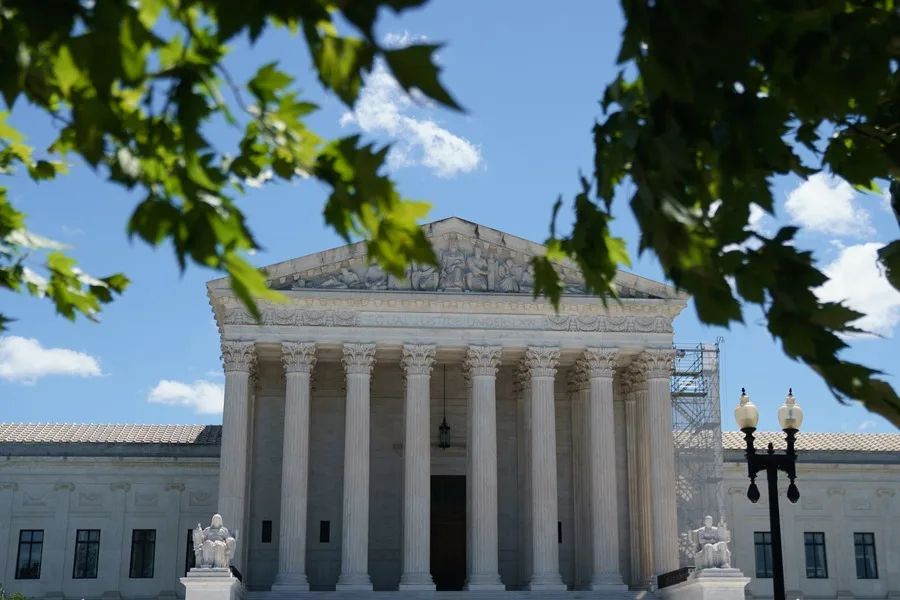
The U.S. Supreme Court on Monday allowed President Donald Trump to proceed with his plan for massive layoffs at the Department of Education, overturning a lower court injunction that had blocked the effort.
The ruling nullifies a temporary restraining order issued by a federal judge in Massachusetts in response to a lawsuit filed by about twenty states, teachers’ unions, and school districts.
Until now, the order had prevented the federal government from carrying out Trump’s plan, announced at the end of March, to cut one-third of the Department’s more than 4,100 employees this year alone.
The Trump administration, which has acknowledged it cannot shut down the Department since that power belongs to Congress, intends to dismantle the agency so that it only retains core functions, such as managing student aid, scholarships, and loans.
Ultimately, the project aims to reduce the Department’s workforce by half, with the goal of returning education powers to the states and eliminating what the administration considers federal budget waste.
As is common in emergency rulings, the majority of justices did not provide a detailed explanation for their decision, which was opposed by the Court’s three liberal justices Sonia Sotomayor, Ketanji Brown Jackson, and Elena Kagan.
Education Secretary Linda McMahon said the ruling confirms “the obvious: that the President of the United States, as head of the executive branch, ultimately has the authority to make decisions about personnel, agency organization, and day-to-day operations.”
“While today’s ruling is an important victory for students and families, it is a shame that the highest court in the country had to intervene to allow President Trump to move forward with the reforms Americans elected him to implement using the constitutional authorities granted to him,” McMahon added in a statement.
Internacionales
U.S. plans five new ‘Alligator Alcatraz’-style migrant detention centers

The U.S. government announced plans to build five new mega detention centers for migrants, modeled after the controversial facility recently opened in Florida, nicknamed ‘Alligator Alcatraz’ by activists and opponents.
Homeland Security Secretary Kristi Noem confirmed that President Donald Trump’s administration is already in talks with five Republican-led states to replicate the model used in the wetlands of southern Florida. “We are working to expand this strategy to more territories with state governments committed to border security,” she said.
These statements follow remarks by Stephen Miller, Trump’s chief immigration advisor, who urged Republican governors in a Fox News interview to contact the Department of Homeland Security (DHS) to facilitate the construction of new centers.
“Pick up the phone, call DHS, work with us to build facilities in your state so we can remove illegals and criminals,” Miller said.
The Florida detention center has faced strong criticism from Democratic lawmakers and human rights organizations due to the inhumane conditions faced by detained migrants. Located in a reptile-infested wetland reserve, the site has become highly controversial.
Last Saturday, a group of Florida federal and state legislators reported that about 750 migrants were “in cages” at the facility after inspecting the site. While Congress members were allowed access, the press remains banned.
Early reports from detainees at ‘Alligator Alcatraz’ describe extreme heat, high humidity, scarce potable water, spoiled food, and makeshift tents used as confinement areas. These conditions have been labeled “inhumane” by migrants themselves and civil organizations.
-

 International4 days ago
International4 days agoTwo missing after torrential rains cause flooding in Catalonia
-

 Central America1 day ago
Central America1 day agoHonduras reports four influenza deaths and 587 cases in 2025 amid COVID-19 rise
-

 International3 days ago
International3 days agoMexico confirms death of farmworker hurt in ICE raid, calls for investigation
-

 International2 days ago
International2 days agoThe rescue operation of missing people ends after a ship was wrecked by a Houthi attack in the Red Sea
-

 International3 days ago
International3 days agoTrump’s 30% tariff undermines U.S.-Mexico talks, but negotiations will continue
-

 International2 days ago
International2 days agoPatriot missiles, key anti-missile systems for the defense of the Ukrainian sky
-

 Internacionales1 day ago
Internacionales1 day agoU.S. plans five new ‘Alligator Alcatraz’-style migrant detention centers
-

 International1 day ago
International1 day agoSupreme Court allows Trump to proceed with massive layoffs at Education Department
-

 International2 days ago
International2 days agoDeaths from clashes between military groups and clans in southern Syria rise to 30
-

 International2 days ago
International2 days agoIsrael kills at least 20 Palestinians in attacks from dawn against the Gaza Strip
-

 International2 days ago
International2 days agoAnti-mafia operation in Italy with 54 arrested for drug trafficking from Ecuador and Spain
-

 International2 days ago
International2 days agoZelenski proposes the Minister of Economy, Sviridenko, as the new prime minister
-

 International1 day ago
International1 day agoTrump gives Russia 50 days to end war in Ukraine
-

 International2 days ago
International2 days agoZelenski talks to Kellogg in Kiev about sanctions against Russia and the sale of weapons to Ukraine
-

 International2 days ago
International2 days agoColombian Senator Uribe Turbay, shows clinical improvement and begins neurological rehabilitation
-
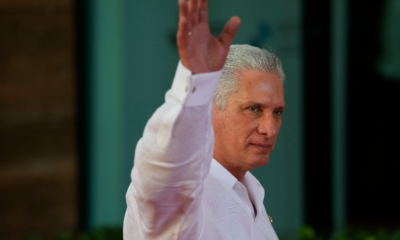
 International4 days ago
International4 days agoU.S. sanctions cuban president Díaz-Canel over regime crackdown on protesters
-

 International1 day ago
International1 day agoThe US Supreme Court gives the green light to Trump to dismantle the Department of Education
-

 International52 seconds ago
International52 seconds agoCivil organizations denounce multinational interference in Latin America’s food policies

























